Estimation of shale volume from well logging data using Artificial Neural Network
The existence of shale has a major effect on reservoir quality because it
reduces the rock’s both the porosity and permeability. There are several
types of shale, and they can be distributed in the sand in four different
ways: laminated, structural, dispersed, or any combination of these. Each
of them has various features and physical properties. Therefore, shale
volume estimation is one of the most important and challengin tasks to be
solved information evaluation. There are many equations proposed to
calculate shale volume from Gamma - ray log; however, none of them
could be considered the best method that can be applied to all case studies.
This study aims to propose a new approach to estimate shale volume from
well - logging data. Gamma - ray and other logs were used as input data
for an artificial neural network (ANN) to predict the shale volume. We
apply this technique to the 1143 data set of the ocean drilling program
(ODP) in the East Sea. The authors compared the result to core data and
recognized that utilization of several logs and ANN gives a better
estimation than conventional methods (more accurate and can reflect the
trend of actual shale volume).

Trang 1
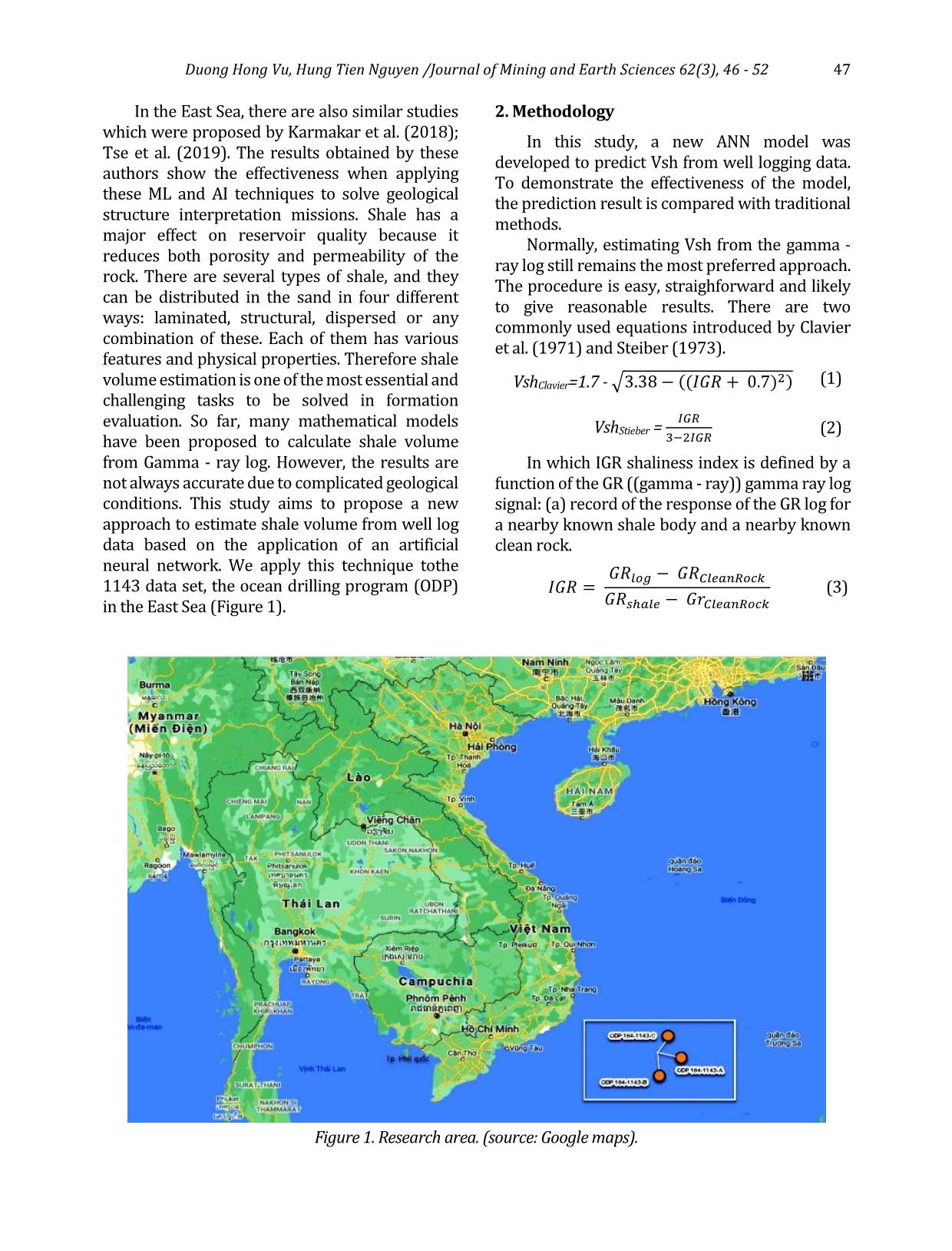
Trang 2
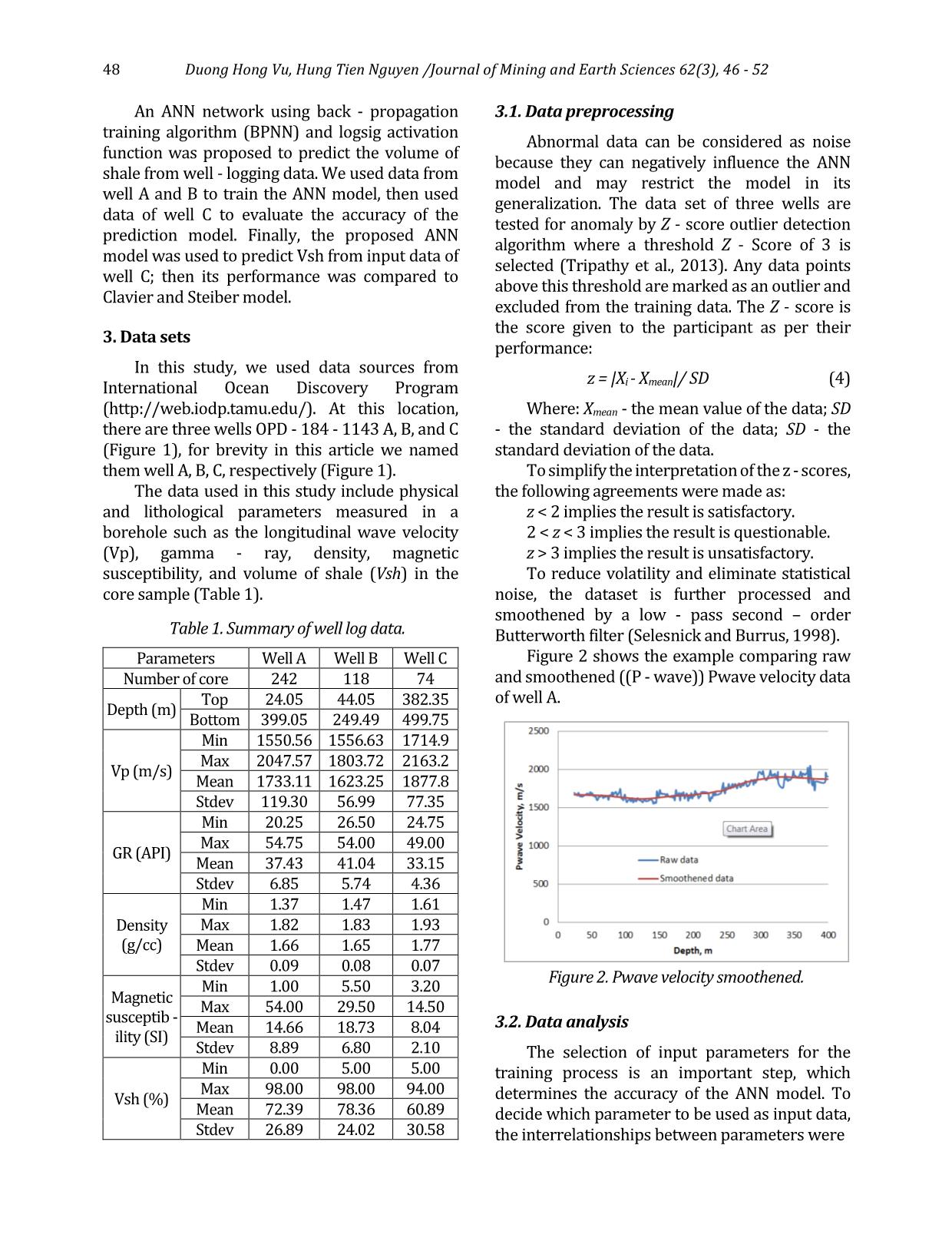
Trang 3
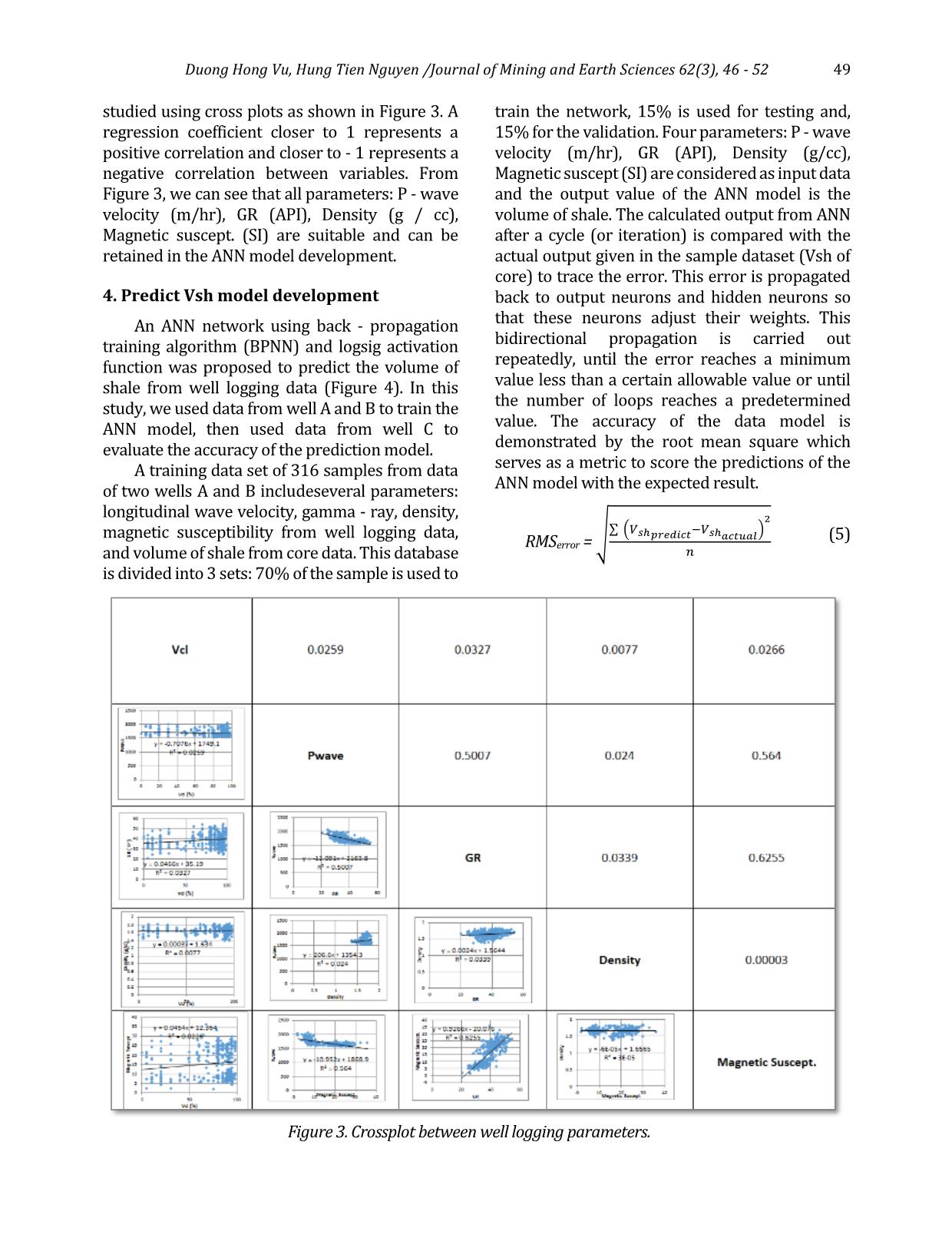
Trang 4
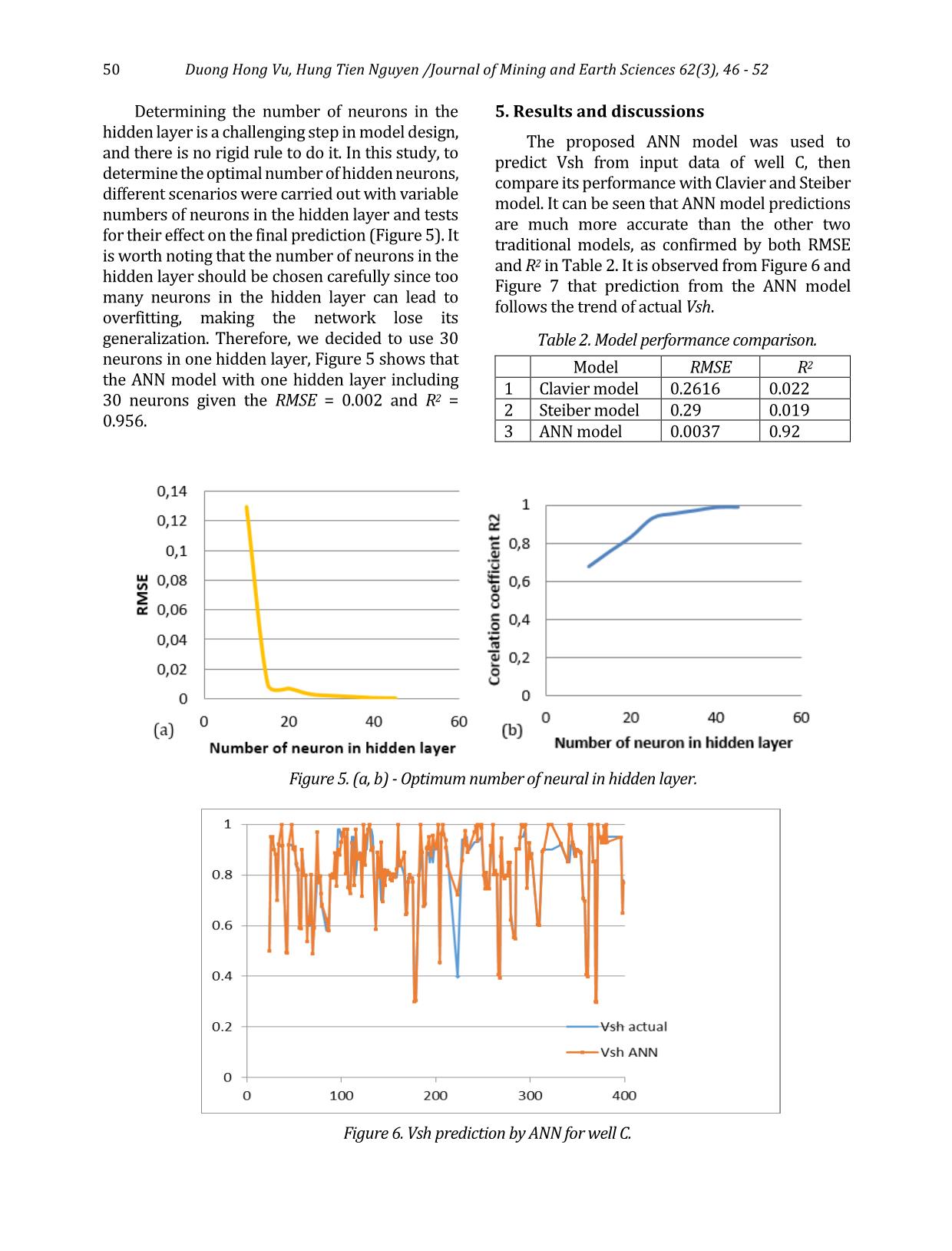
Trang 5
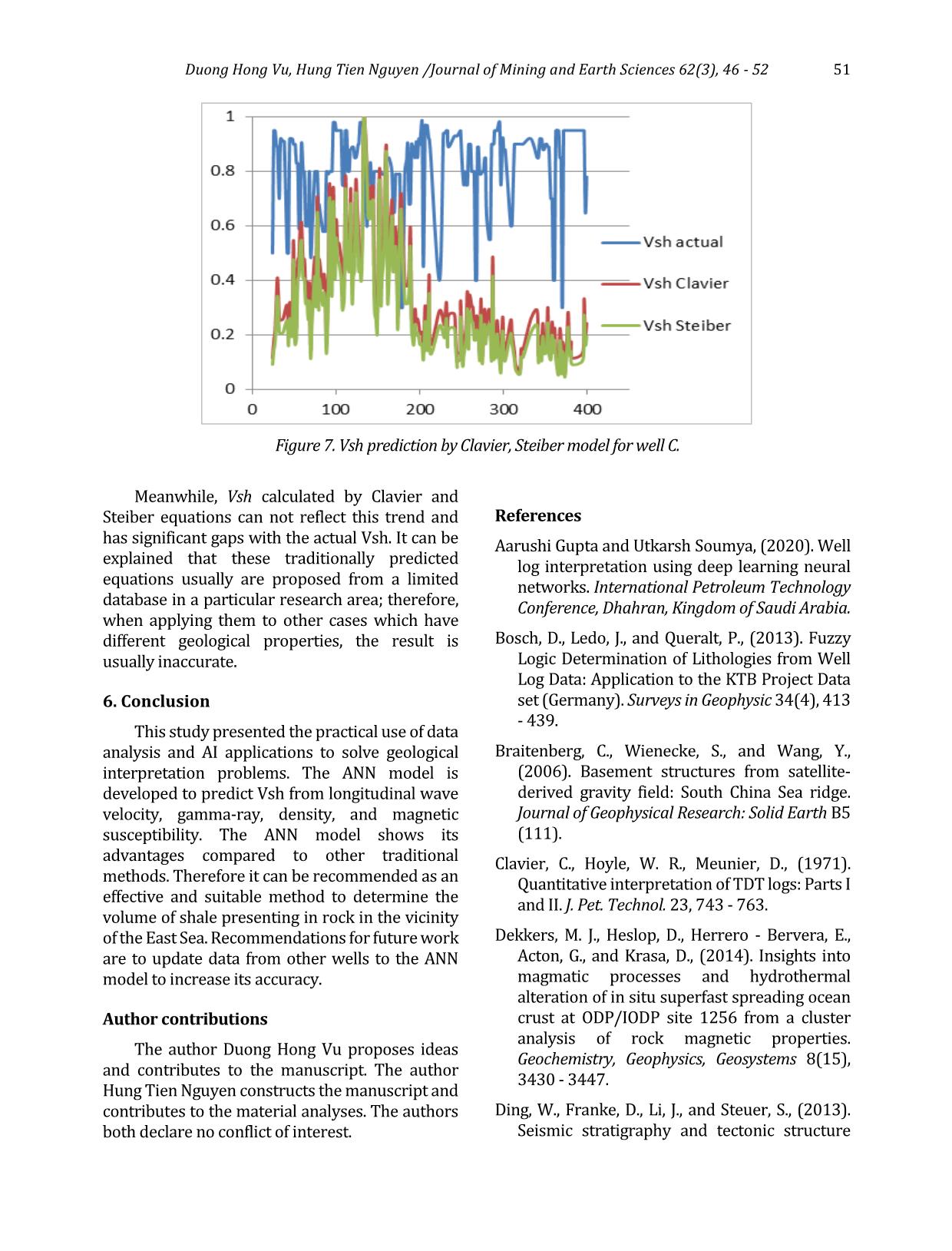
Trang 6
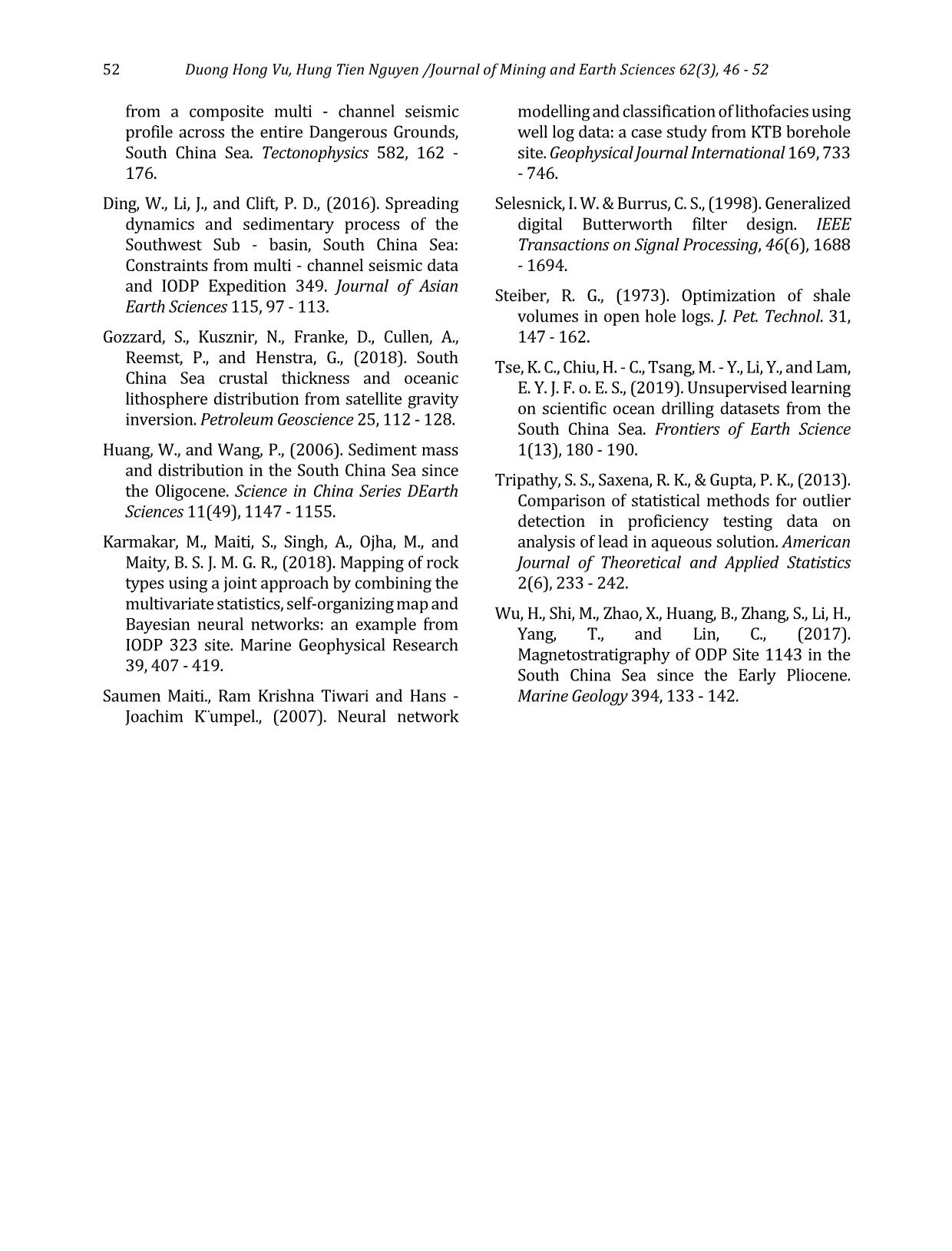
Trang 7
Tóm tắt nội dung tài liệu: Estimation of shale volume from well logging data using Artificial Neural Network
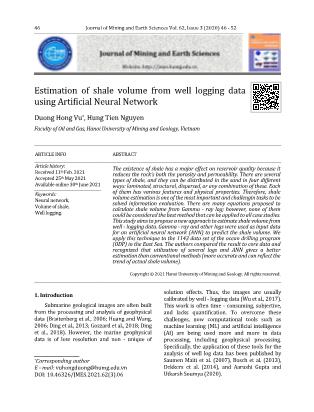
fication. To overcome these challenges, now computational tools such as machine learning (ML) and artificial intelligence (AI) are being used more and more in data processing, including geophysical processing. Specifically, the application of these tools for the analysis of well log data has been published by Saumen Maiti et al. (2007), Bosch et al. (2013), Dekkers et al. (2014), and Aarushi Gupta and Utkarsh Soumya (2020). _____________________ *Corresponding author E - mail: vuhongduong@humg.edu.vn DOI: 10.46326/JMES.2021.62(3).06 Duong Hong Vu, Hung Tien Nguyen /Journal of Mining and Earth Sciences 62(3), 46 - 52 47 In the East Sea, there are also similar studies which were proposed by Karmakar et al. (2018); Tse et al. (2019). The results obtained by these authors show the effectiveness when applying these ML and AI techniques to solve geological structure interpretation missions. Shale has a major effect on reservoir quality because it reduces both porosity and permeability of the rock. There are several types of shale, and they can be distributed in the sand in four different ways: laminated, structural, dispersed or any combination of these. Each of them has various features and physical properties. Therefore shale volume estimation is one of the most essential and challenging tasks to be solved in formation evaluation. So far, many mathematical models have been proposed to calculate shale volume from Gamma - ray log. However, the results are not always accurate due to complicated geological conditions. This study aims to propose a new approach to estimate shale volume from well log data based on the application of an artificial neural network. We apply this technique tothe 1143 data set, the ocean drilling program (ODP) in the East Sea (Figure 1). 2. Methodology In this study, a new ANN model was developed to predict Vsh from well logging data. To demonstrate the effectiveness of the model, the prediction result is compared with traditional methods. Normally, estimating Vsh from the gamma - ray log still remains the most preferred approach. The procedure is easy, straighforward and likely to give reasonable results. There are two commonly used equations introduced by Clavier et al. (1971) and Steiber (1973). VshClavier=1.7 - √3.38 − ((𝐼𝐺𝑅 + 0.7)2) (1) VshStieber = 𝐼𝐺𝑅 3−2𝐼𝐺𝑅 (2) In which IGR shaliness index is defined by a function of the GR ((gamma - ray)) gamma ray log signal: (a) record of the response of the GR log for a nearby known shale body and a nearby known clean rock. 𝐼𝐺𝑅 = 𝐺𝑅𝑙𝑜𝑔 − 𝐺𝑅𝐶𝑙𝑒𝑎𝑛𝑅𝑜𝑐𝑘 𝐺𝑅𝑠ℎ𝑎𝑙𝑒 − 𝐺𝑟𝐶𝑙𝑒𝑎𝑛𝑅𝑜𝑐𝑘 (3) Figure 1. Research area. (source: Google maps). 48 Duong Hong Vu, Hung Tien Nguyen /Journal of Mining and Earth Sciences 62(3), 46 - 52 An ANN network using back - propagation training algorithm (BPNN) and logsig activation function was proposed to predict the volume of shale from well - logging data. We used data from well A and B to train the ANN model, then used data of well C to evaluate the accuracy of the prediction model. Finally, the proposed ANN model was used to predict Vsh from input data of well C; then its performance was compared to Clavier and Steiber model. 3. Data sets In this study, we used data sources from International Ocean Discovery Program ( At this location, there are three wells OPD - 184 - 1143 A, B, and C (Figure 1), for brevity in this article we named them well A, B, C, respectively (Figure 1). The data used in this study include physical and lithological parameters measured in a borehole such as the longitudinal wave velocity (Vp), gamma - ray, density, magnetic susceptibility, and volume of shale (Vsh) in the core sample (Table 1). 3.1. Data preprocessing Abnormal data can be considered as noise because they can negatively influence the ANN model and may restrict the model in its generalization. The data set of three wells are tested for anomaly by Z - score outlier detection algorithm where a threshold Z - Score of 3 is selected (Tripathy et al., 2013). Any data points above this threshold are marked as an outlier and excluded from the training data. The Z - score is the score given to the participant as per their performance: z = |Xi - Xmean|/ SD (4) Where: Xmean - the mean value of the data; SD - the standard deviation of the data; SD - the standard deviation of the data. To simplify the interpretation of the z - scores, the following agreements were made as: z < 2 implies the result is satisfactory. 2 < z < 3 implies the result is questionable. z > 3 implies the result is unsatisfactory. To reduce volatility and eliminate statistical noise, the dataset is further processed and smoothened by a low - pass second – order Butterworth filter (Selesnick and Burrus, 1998). Figure 2 shows the example comparing raw and smoothened ((P - wave)) Pwave velocity data of well A. 3.2. Data analysis The selection of input parameters for the training process is an important step, which determines the accuracy of the ANN model. To decide which parameter to be used as input data, the interrelationships between parameters were Parameters Well A Well B Well C Number of core 242 118 74 Depth (m) Top 24.05 44.05 382.35 Bottom 399.05 249.49 499.75 Vp (m/s) Min 1550.56 1556.63 1714.9 Max 2047.57 1803.72 2163.2 Mean 1733.11 1623.25 1877.8 Stdev 119.30 56.99 77.35 GR (API) Min 20.25 26.50 24.75 Max 54.75 54.00 49.00 Mean 37.43 41.04 33.15 Stdev 6.85 5.74 4.36 Density (g/cc) Min 1.37 1.47 1.61 Max 1.82 1.83 1.93 Mean 1.66 1.65 1.77 Stdev 0.09 0.08 0.07 Magnetic susceptib - ility (SI) Min 1.00 5.50 3.20 Max 54.00 29.50 14.50 Mean 14.66 18.73 8.04 Stdev 8.89 6.80 2.10 Vsh (%) Min 0.00 5.00 5.00 Max 98.00 98.00 94.00 Mean 72.39 78.36 60.89 Stdev 26.89 24.02 30.58 Table 1. Summary of well log data. Figure 2. Pwave velocity smoothened. Duong Hong Vu, Hung Tien Nguyen /Journal of Mining and Earth Sciences 62(3), 46 - 52 49 studied using cross plots as shown in Figure 3. A regression coefficient closer to 1 represents a positive correlation and closer to - 1 represents a negative correlation between variables. From Figure 3, we can see that all parameters: P - wave velocity (m/hr), GR (API), Density (g / cc), Magnetic suscept. (SI) are suitable and can be retained in the ANN model development. 4. Predict Vsh model development An ANN network using back - propagation training algorithm (BPNN) and logsig activation function was proposed to predict the volume of shale from well logging data (Figure 4). In this study, we used data from well A and B to train the ANN model, then used data from well C to evaluate the accuracy of the prediction model. A training data set of 316 samples from data of two wells A and B includeseveral parameters: longitudinal wave velocity, gamma - ray, density, magnetic susceptibility from well logging data, and volume of shale from core data. This database is divided into 3 sets: 70% of the sample is used to train the network, 15% is used for testing and, 15% for the validation. Four parameters: P - wave velocity (m/hr), GR (API), Density (g/cc), Magnetic suscept (SI) are considered as input data and the output value of the ANN model is the volume of shale. The calculated output from ANN after a cycle (or iteration) is compared with the actual output given in the sample dataset (Vsh of core) to trace the error. This error is propagated back to output neurons and hidden neurons so that these neurons adjust their weights. This bidirectional propagation is carried out repeatedly, until the error reaches a minimum value less than a certain allowable value or until the number of loops reaches a predetermined value. The accuracy of the data model is demonstrated by the root mean square which serves as a metric to score the predictions of the ANN model with the expected result. RMSerror = √ ∑ (𝑉𝑠ℎ𝑝𝑟𝑒𝑑𝑖𝑐𝑡−𝑉𝑠ℎ𝑎𝑐𝑡𝑢𝑎𝑙) 2 𝑛 (5) Figure 3. Crossplot between well logging parameters. 50 Duong Hong Vu, Hung Tien Nguyen /Journal of Mining and Earth Sciences 62(3), 46 - 52 Determining the number of neurons in the hidden layer is a challenging step in model design, and there is no rigid rule to do it. In this study, to determine the optimal number of hidden neurons, different scenarios were carried out with variable numbers of neurons in the hidden layer and tests for their effect on the final prediction (Figure 5). It is worth noting that the number of neurons in the hidden layer should be chosen carefully since too many neurons in the hidden layer can lead to overfitting, making the network lose its generalization. Therefore, we decided to use 30 neurons in one hidden layer, Figure 5 shows that the ANN model with one hidden layer including 30 neurons given the RMSE = 0.002 and R2 = 0.956. 5. Results and discussions The proposed ANN model was used to predict Vsh from input data of well C, then compare its performance with Clavier and Steiber model. It can be seen that ANN model predictions are much more accurate than the other two traditional models, as confirmed by both RMSE and R2 in Table 2. It is observed from Figure 6 and Figure 7 that prediction from the ANN model follows the trend of actual Vsh. Model RMSE R2 1 Clavier model 0.2616 0.022 2 Steiber model 0.29 0.019 3 ANN model 0.0037 0.92 Table 2. Model performance comparison. Figure 5. (a, b) - Optimum number of neural in hidden layer. Figure 6. Vsh prediction by ANN for well C. Duong Hong Vu, Hung Tien Nguyen /Journal of Mining and Earth Sciences 62(3), 46 - 52 51 Meanwhile, Vsh calculated by Clavier and Steiber equations can not reflect this trend and has significant gaps with the actual Vsh. It can be explained that these traditionally predicted equations usually are proposed from a limited database in a particular research area; therefore, when applying them to other cases which have different geological properties, the result is usually inaccurate. 6. Conclusion This study presented the practical use of data analysis and AI applications to solve geological interpretation problems. The ANN model is developed to predict Vsh from longitudinal wave velocity, gamma-ray, density, and magnetic susceptibility. The ANN model shows its advantages compared to other traditional methods. Therefore it can be recommended as an effective and suitable method to determine the volume of shale presenting in rock in the vicinity of the East Sea. Recommendations for future work are to update data from other wells to the ANN model to increase its accuracy. Author contributions The author Duong Hong Vu proposes ideas and contributes to the manuscript. The author Hung Tien Nguyen constructs the manuscript and contributes to the material analyses. The authors both declare no conflict of interest. References Aarushi Gupta and Utkarsh Soumya, (2020). Well log interpretation using deep learning neural networks. International Petroleum Technology Conference, Dhahran, Kingdom of Saudi Arabia. Bosch, D., Ledo, J., and Queralt, P., (2013). Fuzzy Logic Determination of Lithologies from Well Log Data: Application to the KTB Project Data set (Germany). Surveys in Geophysic 34(4), 413 - 439. Braitenberg, C., Wienecke, S., and Wang, Y., (2006). Basement structures from satellite- derived gravity field: South China Sea ridge. Journal of Geophysical Research: Solid Earth B5 (111). Clavier, C., Hoyle, W. R., Meunier, D., (1971). Quantitative interpretation of TDT logs: Parts I and II. J. Pet. Technol. 23, 743 - 763. Dekkers, M. J., Heslop, D., Herrero - Bervera, E., Acton, G., and Krasa, D., (2014). Insights into magmatic processes and hydrothermal alteration of in situ superfast spreading ocean crust at ODP/IODP site 1256 from a cluster analysis of rock magnetic properties. Geochemistry, Geophysics, Geosystems 8(15), 3430 - 3447. Ding, W., Franke, D., Li, J., and Steuer, S., (2013). Seismic stratigraphy and tectonic structure Figure 7. Vsh prediction by Clavier, Steiber model for well C. 52 Duong Hong Vu, Hung Tien Nguyen /Journal of Mining and Earth Sciences 62(3), 46 - 52 from a composite multi - channel seismic profile across the entire Dangerous Grounds, South China Sea. Tectonophysics 582, 162 - 176. Ding, W., Li, J., and Clift, P. D., (2016). Spreading dynamics and sedimentary process of the Southwest Sub - basin, South China Sea: Constraints from multi - channel seismic data and IODP Expedition 349. Journal of Asian Earth Sciences 115, 97 - 113. Gozzard, S., Kusznir, N., Franke, D., Cullen, A., Reemst, P., and Henstra, G., (2018). South China Sea crustal thickness and oceanic lithosphere distribution from satellite gravity inversion. Petroleum Geoscience 25, 112 - 128. Huang, W., and Wang, P., (2006). Sediment mass and distribution in the South China Sea since the Oligocene. Science in China Series DEarth Sciences 11(49), 1147 - 1155. Karmakar, M., Maiti, S., Singh, A., Ojha, M., and Maity, B. S. J. M. G. R., (2018). Mapping of rock types using a joint approach by combining the multivariate statistics, self-organizing map and Bayesian neural networks: an example from IODP 323 site. Marine Geophysical Research 39, 407 - 419. Saumen Maiti., Ram Krishna Tiwari and Hans - Joachim K¨umpel., (2007). Neural network modelling and classification of lithofacies using well log data: a case study from KTB borehole site. Geophysical Journal International 169, 733 - 746. Selesnick, I. W. & Burrus, C. S., (1998). Generalized digital Butterworth filter design. IEEE Transactions on Signal Processing, 46(6), 1688 - 1694. Steiber, R. G., (1973). Optimization of shale volumes in open hole logs. J. Pet. Technol. 31, 147 - 162. Tse, K. C., Chiu, H. - C., Tsang, M. - Y., Li, Y., and Lam, E. Y. J. F. o. E. S., (2019). Unsupervised learning on scientific ocean drilling datasets from the South China Sea. Frontiers of Earth Science 1(13), 180 - 190. Tripathy, S. S., Saxena, R. K., & Gupta, P. K., (2013). Comparison of statistical methods for outlier detection in proficiency testing data on analysis of lead in aqueous solution. American Journal of Theoretical and Applied Statistics 2(6), 233 - 242. Wu, H., Shi, M., Zhao, X., Huang, B., Zhang, S., Li, H., Yang, T., and Lin, C., (2017). Magnetostratigraphy of ODP Site 1143 in the South China Sea since the Early Pliocene. Marine Geology 394, 133 - 142.
File đính kèm:
 estimation_of_shale_volume_from_well_logging_data_using_arti.pdf
estimation_of_shale_volume_from_well_logging_data_using_arti.pdf

